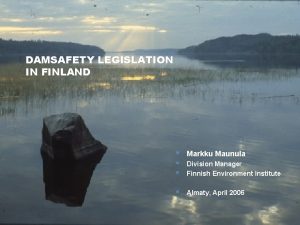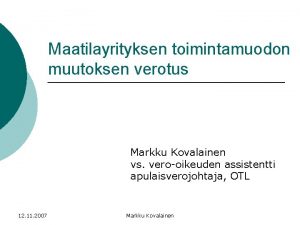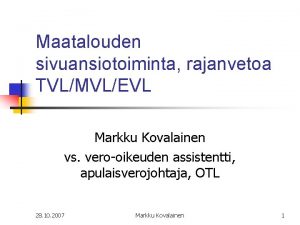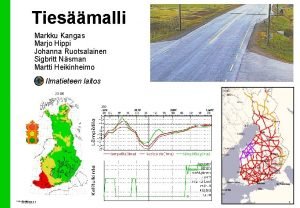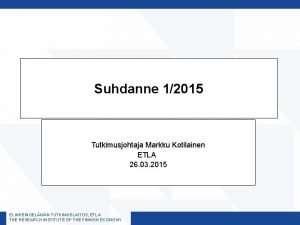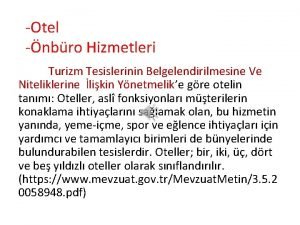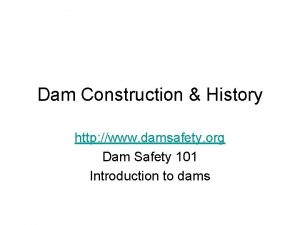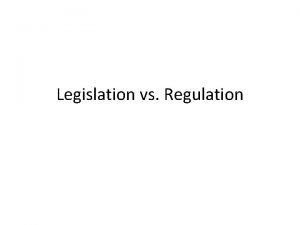DAMSAFETY LEGISLATION IN FINLAND Markku Maunula Division Manager





















- Slides: 21

DAMSAFETY LEGISLATION IN FINLAND § Markku Maunula § § Division Manager Finnish Environment Institute § Almaty, April 2006

Water resources Climate § Finland is climatically located in a transition zone between a maritime and a continental climate § Due to the influence of the Gulf stream and the Baltic Sea, the climate is more favourable than in most other regions located between the 60 th and 70 th latitudes

Water resources Precipitation statistics Mean monthly precipitation in Helsinki, mm Mean annual precipitation, mm

Water resources The land of waters § § § 187 888 lakes (total area 33 350 km²) 314 000 km of shoreline 178 947 islands 22 085 springs 647 rivers Freshwater reserves: 108 000 Mm 3/a 21 000 m 3/a capita Proportion of water in the area

Water resources Floods § Floods are natural phenomena causing trouble and damages also in Finland § Reasons for floods: • • • § increased discharges due to melting of snow in the spring damming ice blocks heavy rainfalls The extent and impacts of floods depend greatly on • • local landforms and land use practices flood control, regulation of river systems


Water resources management Regulating inland waters § Water level regulation projects affect around 300 lakes (third of the total area of lakes) § Most of regulation work was done between the 1950 s and the 1970 s in order to reduce flooding, to produce hydropower, to facilitate water transportation and to improve the water supply § More recently issues like nature conservation and recreational values have become more important § Permits must be obtained for all water regulation projects from the environmental permit authorities, according to the provisions of Finland's Water Act

Water resources management Flood forecasts § Watershed models cover 85 % of the country § Forecasts are made daily for 300 discharge and water level observation points § Forecasts are used for regulation, flood damage prevention and general information

Background § 1984: The Act and Decree on Dam § 1985: Dam Safety Code of Practice § 1997: The third revised Dam Safety were enacted to improve the safety of dams applying the statutory regulations as practical guidelines. Safety Code Practice was issued.

The Act and Decree on Dam Safety § § Some 500 of Finland's dams are covered by the legislation. Of these, 85% are waterbody dams and 15% waste dams. In the event of an accident, about 40 of the dams would endanger human life or health or cause considerable damage to the environment or property. Most of the dams are embankment dams, and a few are massive concrete dams. Dams in Finland are constructed mainly for • • • Flood control Hydroelectric power production Water supply Fish culture Storing waste detrimental to health or the environment

Classification of the dams § Dams are classified by the type of hazard risk they pose in the event of an accident or because of their impermanence. In addition to the risk of damage downstream from the dam the risk due to a sudden drop in water level upstream from the dam should also be considered. • • P dams an accident would cause apparent danger to human lives, health or a threat to environment or property N dams minor threats than P dams, but not acceptable into O class O dams only minor threats T dams temporary dams (coffer dams)

Damsafety authorities § The supreme authority of supervision and guidance: The Ministry of Agriculture and Forestry § The local authorities: The regional environment centres § The rescue services: The regional rescue departments § The Finnish Environment Institute developes dam safety and performs condition surveys for the dams owned by the state and gives expert services to the ministry and the regional environment centres.

Dam safety act 1/4 Scope of application § § § The Act applies the building and use of a dam. A dam is a construction intended for permanent use with the associated structures and facilities regardless of the construction materials or methods or the type of substance impounded in the basin. This Act shall be applied to a dam not less than three meters high. The Act shall, however, also be applied to a lower dam, if the volume of the substance in the basin impounded by the dam is so large or if the substance in the basin is of such a type that in the event of an accident it manifestly endangers human life or health or manifestly seriously endangers the environment or property.

Dam safety act 2/4 Commitments § § § The construction of a dam shall be carried out such that in structure and strength it meets the requirements that a safety risk shall not arise from either the dam itself or its use. The owner of a dam shall be obliged to keep the dam in a condition such that it is safe and it will not cause a hazard or have damaging or harmful effects on public or private interest. The dam owner or holder shall store documents relevant to dam safety in a special safety file.

Dam safety act 3/4 Monitoring § § § To reduce the risk of damage from a dam a safety monitoring programme shall be drafted for each dam The dam safety monitoring programme shall be drafted by the dam owner or holder. The programme may include rules concerning the monitoring proper and the inspections made at regular intervals. The approval of the safety monitoring programme or its amendments shall be decided by the regional environment centre.

Dam safety act 4/4 Hazard risk assessment § § To determine and assess the risk arising from a dam the regional environment centre may order, whenever so required, the dam owner or holder to acquire an assessment of the risk posed by the dam to the downstream population and property in particular (hazard risk assessment) and to communicate the findings of the assessment to the regional environment centre and the municipal rescue authority. A dam referred to in this Act that in the event of an accident may manifestly endanger human life or health or manifestly seriously endanger the environment or property shall be included as a risk site in the coordination plan. The dam owner or holder shall be obliged to assist the rescue authorities in drawing up the plan.

The Safety File § The Safety File shall contain to the extent required by circumstances the following documents: 1. an account of the main dimensions of the dam and dammed area and the hydrological parameters used in planning; 2. a map of the area affected by the dam, the location drawing of the dam, and drawings and documents of the dam structure in so far as they are needed to assess dam safety; 3. the safety monitoring programme 4. the monitoring and inspection records; 5. the letters from the authorities required to be included in the file; and 6. the assessments and action plans

The Safety Plan § The Safety Plans shall contain: 1. a plan of measures to be taken with regard to the waterbody and hydraulic structures in the event of an accident; 2. an account of the materials to be reserved in advance to forestall an accident; 3. a description of the manner in which the regional alarm will be given and communication will be maintained with the regional alarm centre; 4. information about the personnel of the dam owner or holder available to prevent the damage in the event of an accident; 5. an account of other measures of the dam owner or holder necessary to protect people and property in the event of an accident caused by the damming; and 6. in respect of waste dams, a description of the type and quantity of the impounded substance.

Dam safety code of practice Contents § § § § Application of legislation Dam requirements • • • Hydrological design Structures (earth and rock, concrete, steel) Machinery Electrical facilities Monitoring and control facilities The content of dam safety file Commissioning inspection Safety monitoring and inspections Hazard risk assessment Prevention of and precautions against a dam accident

Dam safety: Hazard risk assesment Dam Break Hazard Analysis § To be analysed: • • C B A • • different breach locations and scenarios different hydrological conditions people in risk economical and environmental damages

Inspections Annual inspection § In the annual inspection special attention shall be paid to checking the condition, performance and alarm systems of the dam spillways and sills and power plant discharge facilities. The operation of the facilities must be checked with test runs. In flood years in particular, the flood preventive measures taken are reviewed, so that even in abnormal flood years the operating personnel have the correct instructions for handling the situation. Regular inspection § A regular inspection is made at intervals not exceeding five years. The date of the first regular inspection is counted from the date of the commissioning inspection. § A representative of the dam owner or holder and a competent person participate in the regular inspection. § The regional environment centre and, for a P dam, the provincial government, the rescue authorities shall be informed about the date of the inspection so that the authorities can participate in the inspection. The reports of disturbances § Structural and operational disturbances affecting dam safety and observed during monitoring must be reported.
 Markku maunula
Markku maunula Ira verma
Ira verma Markku kovalainen
Markku kovalainen Organizational inertia
Organizational inertia Lindblad lappeenranta
Lindblad lappeenranta Markku kovalainen
Markku kovalainen Data preparation for data mining
Data preparation for data mining Yritysmuodot selkokielellä
Yritysmuodot selkokielellä Markku tikkanen
Markku tikkanen Markku stenborg
Markku stenborg Markku mäki-hokkonen
Markku mäki-hokkonen Markku leskinen
Markku leskinen Markku kangas
Markku kangas Markku rimpelä
Markku rimpelä Markku ursin
Markku ursin Markku turunen fysiatri
Markku turunen fysiatri Markku kotilainen
Markku kotilainen Markku mylly
Markku mylly Senior manager vs general manager
Senior manager vs general manager Portfolio manager synergy manager parental developer
Portfolio manager synergy manager parental developer Room division manager görev tanımı
Room division manager görev tanımı Delegated legislation meaning
Delegated legislation meaning
